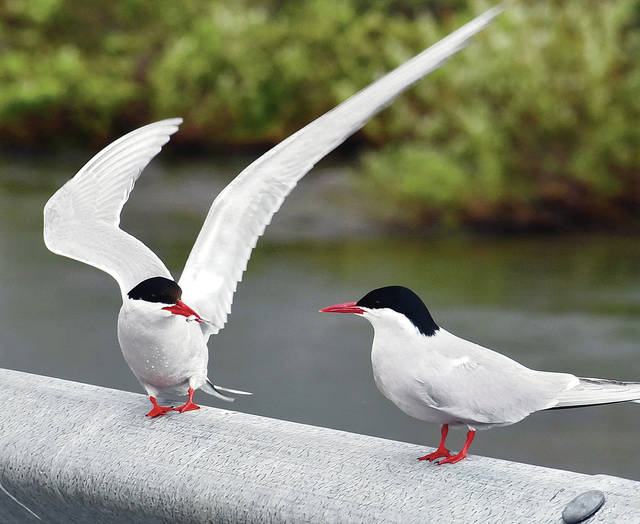Published in the Ocean Watch column, Honolulu Star-Advertiser © Susan Scott
June 30, 2018
In some ways Alaska and Hawaii are worlds apart. But after my weeklong work with Pacific golden plovers in Nome, I learned that we also have much in common.
Both states joined the union in 1959, and both are physically disconnected to what we in Hawaii call the mainland and Alaskans call the Lower 48. It’s logical, too, that given their long, dark winters, most of the Nome residents I met have migrated, or are planning a migration, to Hawaii.
As do other species.
Each year about 10,000 humpback whales make the 3,000-mile (one-way) migration between Hawaii and Alaska, feasting on krill, plankton and fish in the North’s summer waters. When winter sets in, the whales head south, giving birth to their babies in our warm tropical waters.
 One Arctic tern offers a fish gift to another.
One Arctic tern offers a fish gift to another.
©2018 Susan Scott
Because our plover work was on the tundra, we didn’t see whales on this trip. When we had views of the Bering Sea, though, we looked for spouts and gave silent salutes to Hawaii’s humpbacks.
Also migrating between warm and cold climates are countless shorebirds. The Alaska tundra offers 24-hour insect feasts. Besides the kolea, prominently featured in Nome’s visitor center, I spotted a wandering tattler and a bristle-thighed curlew, both shorebirds that winter in Hawaii.
I didn’t see Hawaii’s other two common shorebirds, but they’re there. When we arrived in Nome, we met a Brigham Young University- Hawaii researcher studying Hawaii’s ruddy turnstones. Those, as well as the little sanderlings, known in Hawaii as hunakai, all lay eggs and raise chicks in Alaska, and winter in Hawaii and other tropical islands.
One amusing incident on my trip occurred when we stopped on a bridge over a river to see some salmon relatives called Arctic char. Before we got out of the car, an Arctic tern landed on the railing.
The stunning white bird had a black cap and brilliant red feet, legs and bill. As I raised my camera, a second tern landed with a fish gift for the first, similar to what our white terns do while courting.
During the transfer, however, the fish fell to the road. The courting tern swooped down, but before it could retrieve its present, the live fish wiggled over the edge and into the river below.
Arctic terns are the gold medalists of migrating birds, each year flying between the Arctic and Antarctic in pursuit of endless summer. The 3- to 4-ounce terns travel an astonishing 24,000 miles yearly for decades. The oldest known Arctic tern was 34 years old.
A main reason for the evolution of migration is the earth’s freezing and melting cycles, about 20 in the last 2.5 million years.
No one knows what migratory changes will occur due to the rapid warming we humans are currently causing, but we do know one thing: Whatever the shape, size or color of migrants, Hawaii welcomes them with aloha.